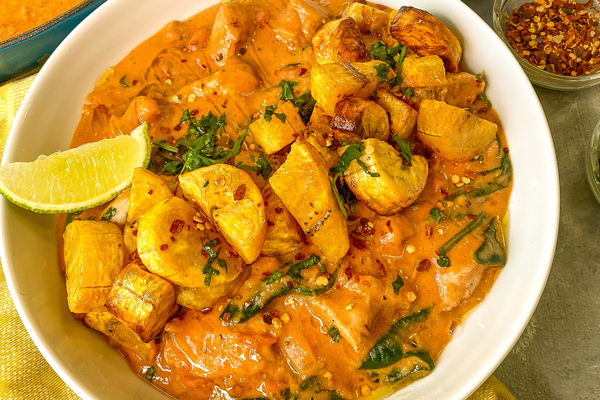Adrienne Royer's layoff notice came right before Christmas. Her finances now are, by her description, "extremely tight." That puts her in good company these days. Many women have lost jobs, had working hours cut back, seen their savings disappear or are living on fixed incomes.
Like many financially stressed people, Adrienne decided to reduce what she was spending on food. Yet she was determined to eat healthy, for weight control and to prevent future medical problems.
Although conventional wisdom says it's not possible to buy fruits, vegetables, whole grains and healthy proteins when your income is limited, that hasn't been her experience. "In many ways, I've found that being on a tight budget has helped me eat healthier," says Adrienne, who is 28 and lives in Alexandria, Virginia.
Food expert Kathy D. McManus, MS, RD, LDN, agrees that it's possible to cut costs and still have a healthy diet. "The fun thing about it is, even as we have to be more careful with money, we don't have to sacrifice taste or nutritional benefit," says McManus, who is director of the department of nutrition at Brigham and Women's Hospital in Boston.
16 great ways to cut costs
Government studies show that—regardless of income level—we all need to improve our diets. Try these sure-fire suggestions for making your food shopping both healthful and economical:
Get inspired. Read the weekly food store ads and make a shopping list as you read. McManus says many of us skip this simple step, which can pay off big. Choose sale items that are whole foods such as vegetables, fruits and grains—not processed—to plan menus. "I put dinners together from that sale paper. If it's not on sale, I don't buy it," says Brenda Parker, 44, a Rialto, California, woman who chooses healthful foods for five children ages 11 and younger, her husband and herself. Plan at least three dinners, with leftovers to be re-created into other meals.
Think strategically. Check your kitchen shelves before you go shopping, so you don't buy what you already have. Always use a list. If you don't, you're more likely to end up with expensive impulse purchases you don't need, McManus says. Clip coupons for healthy items such as old-fashioned oatmeal, guacamole and yogurt.
Adrienne has cut her food budget in half, in part by having a more purposeful plan. "Now I'm not just wandering around the store aimlessly wondering, 'What do I want to eat?'" Other strategies that save: shop just once a week, leave the kids with someone else while you shop, and try store brands—they're usually much cheaper, with the same nutrition (many stores also have their own organic or natural foods lines).
Eat in season and whole. Produce that's in season in your area costs less and usually is more nutritious than out-of-season fruits and vegetables picked before ripening and shipped thousands of miles. You'll find fresh local produce at farmers' markets, some supermarkets and clubs (see next tip). Presliced or chopped fruits and vegetables are expensive, so do the cutting yourself and save. Bonus: fresh-cut produce tastes better than most precut varieties.
Join the club. Check out food buying clubs, food co-ops and community supported agriculture groups (CSAs) in your area for fresh-from-the-farm produce and other whole foods. These groups are usually nonprofit and encourage sustainable farming. Some require a bulk purchase, so you may want to share with friends or neighbors. Rules for membership vary and may include volunteering for a few hours. Traditional wholesale clubs, like the national chains, carry some whole foods in bulk. Adrienne splits five-pound bags of salad mixes, celery and baby carrots with her mother.
Lean protein can cost less—sometimes a lot less. Are you stuck in a boneless chicken breast rut? There are lots of ways to get healthful lean protein for less. Dried peas and beans, lentils and garbanzos (used in hummus) all provide protein, complex carbohydrates—those are the good carbs—and lots of fiber, for just pennies per serving.
In addition, McManus suggests serving eggs for dinner (think a vegetable frittata or omelet). "Eggs are an inexpensive and great source of protein, choline and other wonderful nutrients," she says. Canned fish, lean ground turkey, tofu and seitan (wheat gluten) are also standouts for protein. Light tuna is low-cost and lower in mercury than albacore; canned salmon is usually wild, not farmed, and less expensive than fresh.
Try new grains. Whole grains are affordable, versatile health powerhouses that beat their refined (bleached, cut or milled) versions any day. Change white rice to brown (there are more than six types sold in the United States); add barley to soups; use buckwheat and bulgur for a nutty flavor; choose whole grain bread. Quinoa, from Latin America, cooks easily and is higher in protein than some other starches, McManus says. Her hospital makes big batches of quinoa and offers it on the menu every day. Many stores sell whole grains out of bulk bins, so you can scoop as little or as much as you need.
Switch your cooking gears. "The secret to healthful, inexpensive and non-boring fare lies in the careful infusion of bold flavors," says Belinda Hulin, author of The Knack Chinese Cooking. A little fresh-grated ginger root, garlic, green onion, cilantro or citrus juice can transform foods inexpensively without fatty sauces. Hulin suggests stir-frying leftover chicken with julienne cuts of vegetables, aromatic seasonings, a sprinkling of chopped almonds and a splash of low-sodium soy sauce, served with brown rice. Chinese steamed dishes make dessert healthful, too—try steamed apples or pears drizzled with a bit of honey and lemon juice.
Make friends with your freezer. Commercially frozen vegetables and fruits are picked when ripe, so they can be more nutritious than out-of-season fresh produce that's been shipped long distances. Bags of frozen vegetables are low-cost and convenient, so you use only what you need. Choose products frozen without sauce or syrup—they're cheaper and better for you. When cooking soups and main dishes, make extra for freezing. If you eat meat, take advantage of bulk sales, then repackage and freeze in smaller-use units.
Budget help for special diets. Linda Fullerton, 54, can only eat gluten-free foods, which rarely go on sale. The New York woman also is on a fixed income, so the costlier foods she needs can strain her wallet. Linda checks manufacturers' Web sites for coupons on gluten-free items and offsets her food bill by shopping carefully for sales and coupons on non-food needs. Likewise, Brenda and her son are lactose-intolerant, so they drink lactose-free milk, which costs more. She also adds other non-dairy sources of calcium to their meals, such as broccoli.
Organic or not? Organic produce and other items are usually more expensive than conventional foods. Learning which fruits and vegetables contain the least (or most) pesticide residue may help you decide which organics to buy, if any. According to the nonprofit Environmental Working Group, the lowest pesticide levels are in onion, avocado, sweet corn, pineapple and mango. The highest: peach, apple, bell pepper, celery and nectarine. See the full list at www.ewg.org.
Organic produce may be cheaper at farmers' markets, co-ops, CSAs, wholesale clubs and deep discounters. "It's very definitely a personal choice. The bottom line is let's try to eat more healthfully," says nutritionist McManus. "My philosophy is to eat more local and unprocessed foods, even if conventional."
Find better substitutes. Instead of buying sugar-free and fat-free packaged foods, choose whole foods that have little or no sugar and fat. Adrienne stopped buying baked chips and low-fat cookies. "Healthy junk food tends to be more expensive," she says. "I eat fat-free popcorn for a lot less." She carries snacks such as baby carrots or low-fat string cheese in her purse for when she's not at home. Get reusable containers to carry dips for apples and carrots, rather than paying for expensive, premade snack packs.
Change two or three meals to meatless. Getting meat—especially saturated-fat-laden red meat—out of your recipes helps your finances and health. Brenda made the transition slowly, by cooking part of the meal without meat for herself and serving meat to her children and husband. "The kids asked me how my food tasted, tried it one at a time and didn't even miss the meat," she says. Now the family has eliminated red meat and has three meatless dinners weekly. Because of her skill at feeding her family healthfully on a budget, Brenda was named a Champion for Change, part of a California state network that encourages nutritious eating and physical activity. Brenda finds recipes and ideas at the Web site, which she shares, as a volunteer, with other women.
Control waste. That four-pound bag of oranges looks great and saves money, but it's not cost-effective if the fruit spoils before you can use it all. If you have a small household or are the only one at home who eats something, check to see if friends will share with you before you buy. Examine pre-bagged and boxed produce carefully for soft spots or mold. Grains and nuts scooped from bulk bins are often more economical than packaged versions, if you buy and store only what you can use in time.
Drink to your health. Make water your beverage of choice. If you have concerns about your local water, buy a water-filtering pitcher to keep in the refrigerator. Eliminate alcohol and sodas from regular meals or snacking—you'll improve your health and budget.
Dine out at home. Eating at home is cheaper and usually healthier than restaurant dining, but what about the fun of socializing? And isn't it nice when someone else cooks? You can have the enjoyment and ease of dining out by holding pot luck dinners with your friends. Agree on which types of foods to cook, have everyone bring a dish and help with clean-up and change host homes every month. Add candles on the table and voilà—a special, fun dining event!
Create your own food. Growing even a little bit of your own food has huge benefits. You get the nutrition and taste of just-picked produce, healthy physical activity and low costs. In low-income urban and rural areas—both of which have little access to stores with healthful foods—home and community gardens eliminate transportation problems as well.
"We have saved so much money," says Brenda, who grows tomatoes and other vegetables with no pesticides and trades with neighbors who grow chili peppers, lemons and avocados. "Team up when you can," she advises.
You can grow food in your yard, on your patio or in a window without fancy gardening supplies, says Holly Hirshberg, executive director of The Dinner Garden, a nonprofit that distributes free vegetable and fruit seeds throughout the United States. The group's typical packet contains enough seeds to feed a four-person household. It also provides seeds to community gardens and offers growing advice online. Seeds are donated and match your growing region. Most gardeners they hear from "have never needed help before the economy hit," Hirshberg says. "Many save seeds (from their crops) and send them back to give to others. We love that."
Looking to bake something healthy for your special sweetheart? Find our best tips on baking light here.







